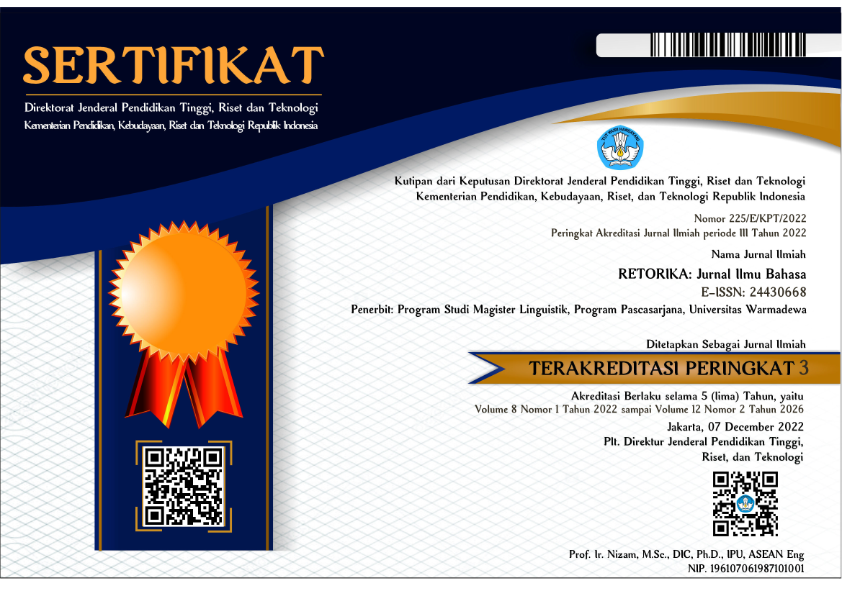An Analysis of Pronunciation Errors Made by Medical Students at S&I Learning Centre
Abstract
This study discusses about pronunciation errors made by medical students at S&I Learning Centre. The study aims to describe the types of pronunciation errors found in students' utterances using descriptive qualitative method. The subject are medical students at S&I Learning, meanwhile the object of this exploration are students' utterances in English. The data was collected through audio recording and then those was analysed by using theory proposed by Corder by classifying errors into three types. The results show that the sorts of pronunciation errors created by medical student and 2) the cause of pronunciation errors produced by medical students. Students’ pronunciation errors are also classified into three types. Those are interference errors, intralingual errors, and developmental errors. In speaking, teacher and students had their effect to each other. The teacher has duties to assess and address the error of students by addressing the errors produced by learners permanently, particularly at the time when they drilled and practiced the correct pronunciation in speaking skill. In addition, students too should be more dynamic in surveying and correcting the pronunciation themselves. They have to create and improve their pronunciation capacity by appreciating the hypothetical about legitimate phonological. In accordance with this reason, it is necessary to apply an appropriate learning model to reduce pronunciation errors produced by students.
References
Brown, H. D. (1980). Principles of Language Learning and Teaching (5th ed.). New Jersey: Prentice Hall Inc.
Cheng, X. (2015). Interlanguage-based Error Analysis in Higher Vocational and Technological College EFL Education in China. Journal of Language Teaching and Research, 6(3), 639–646.
Corder, S. P. (1974). Error Analysis. Oxford: Oxford University Press.
Heydari, P., & Bagheri, M. S. (2012). Error Analysis: Sources of L2 Learners’ Errors. Theory and Practice in Language Studies, 2(8), 1583–1589.
Hornby, A. S. (2008). Oxford Advanced Learner’s Dictionary of Current English. New York: Oxford University Press.
James, C. (1998). Errors in Language Learning and Use: Exploring Error Analysis. Harlow: Addison-Wesley Longman.
Ladefoged, P., & Johnson, K. (2011). A Course in Phonetics. Boston: Wadsworth Publishing (CENGAGE Learning).
Lang, P. (2009). Introduction to English Phonetics and Phonology. Frankfurt: Internationaler Verlag der Wissenschaften.
Ramasari, M. (2017). Students’ Pronunciation Error Made in Speaking for General Communication. Linguistic, English Education and Art (LEEA) Journal, 1(1), 37–48.
Richards, J.C. (1974). Error analysis Perspectives on Second Language Acquisition. London: Longman.
Richards, Jack C, & Schmid, R. (2002). Longman Dictionary of Language Teaching and Applied Linguistics (3rd ed.). London: Pearson Education Limited.
Sudaryanto. (2015). Metode dan Aneka Teknik Analisis Bahasa: Pengantar Penelitian Wahana Kebudayaan secara Linguistis. Yogyakarta: Duta Wacana University Press.
Tarigan, G., & Tarigan, D. (1988). Pengajaran Analisis Kesalahan Berbahasa. Bandung: PT Rineka Cipta.
Copyright (c) 2020 RETORIKA: Jurnal Ilmu Bahasa

This work is licensed under a Creative Commons Attribution-ShareAlike 4.0 International License.
This journal provides immediate open access to its content on the principle that making research freely available to the public supports a greater global exchange of knowledge.
All articles published Open Access will be immediately and permanently free for everyone to read and download. We are continuously working with our author communities to select the best choice of license options, currently being defined for this journal as follows: Creative Commons-Non Ceomercial-Attribution-ShareAlike (CC BY-NC-SA)
 Abstract viewed = 348 times
Abstract viewed = 348 times
 PDF downloaded = 1149 times
PDF downloaded = 1149 times

2.png)














